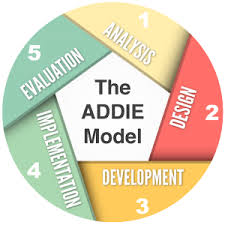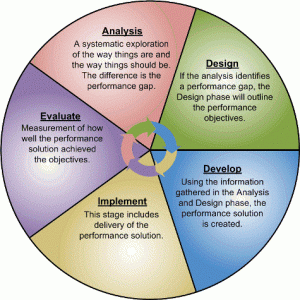ADDIE: Relic or Still Relevant?

Prior to starting the MATD program at Roosevelt, most of my training and organizational experiences came from someone at work saying, “Hey, we need this. Can you do it?”. Therefore, I’m constantly grilling, er, speaking with instructional design professionals about their experiences. One theme that has come up frequently in these discussions is that the ADDIE instructional design methodology is rarely replicated in the workplace the way it is taught in school. To be honest, I freaked out just a teeny tiny bit. What if the way I learned instructional design was antiquated? What if I show up to job interview sounding like I’m from 1976?
Before we delve too deeply into grad student angst, let’s take a second to review some basics. The image below offers a quick primer on ADDIE for readers who are unfamiliar with this instructional design approach. ADDIE is an acronym for Analysis, Design, Develop, Implement and Evaluate. It maps out a path to instructional design that works to ensure that the design process flows as seamlessly as possible from one action to the next, building on the work of the previous step.
I sought to answer the question of relevance by polling colleagues and classmates via LinkedIn and researching the topic online. The consensus, in my unscientific LinkedIn poll, was that although ADDIE was not used stringently, it was the basis of other methodologies. Reasons for using these offshoot approaches varied, but a consistent theme of time and budget constraints were cited.
 After combing the Internet, I uncovered some useful articles that mirrored my polling. ADDIE is not irrelevant; it is evolving and still very much in use. Rapid prototyping, SAM/Agile, and other in-house developed processes are often employed more frequently. Faster outputs with fewer revisions and a need for ongoing evaluation of the process and product seem to be driving the changes (Gutierrez, 2015; Pappas, 2015).
After combing the Internet, I uncovered some useful articles that mirrored my polling. ADDIE is not irrelevant; it is evolving and still very much in use. Rapid prototyping, SAM/Agile, and other in-house developed processes are often employed more frequently. Faster outputs with fewer revisions and a need for ongoing evaluation of the process and product seem to be driving the changes (Gutierrez, 2015; Pappas, 2015).
Well, there you have it. ADDIE is still alive and kicking. It looks like we will be using it or a close cousin of it for years to come. Hurrah! I won’t seem like a 70’s throwback in my job interviews. I should have known Roosevelt University would not let me down.
Continue the Conversation
What has your experience with ADDIE been? Good? Bad? Ugly?
Do you wish you had read another blog post, because duh, so obvious? Why or why not?
References and Links
ADDIE Solutions. (n.d.).The Addie Model. (n.d.). Retrieved November 21, 2016, from http://addiesolutions.com/blog/addie
Bottom Line Performance. (2016). Agile vs. ADDIE: Which Is Better for Learning Design? Retrieved November 21, 2016, from http://www.bottomlineperfomance.com/agile-vs-addie-which-is-better-for-learning-design/
Gutierrez, K. (2015, July 9). The Ins and Outs of Rapid Prototyping for eLearning. Retrieved November 21, 2016, from http://info.shiftelearning.com/blog/rapid-prototyping-for-elearning
Hodell, C. (2015, January 13). All About ADDIE. Retrieved November 21, 2016, from https://www.td.org/Publications/Newsletters/Links/2015/01/All-About-ADDIE
Inc., A. I. (n.d.). Agile eLearning Development with SAM | Allen Interactions. Retrieved November 21, 2016, from http://www.alleninteractions.com/sam-process
Pappas, C. (2015). The Power Of AGILE Instructional Design Approach. Retrieved November 21, 2016, from https://elearningindustry.com/the-power-of-agile-instructional-design-approach
Russell, L. (2015). Methodology Wars: ADDIE vs. SAM vs. AGILE. Retrieved November 21, 2016, from https://www.td.org/Publications/Blogs/L-and-D-Blog/2015/04/Methodology-Wars
Special Thanks to LinkedIn Respondents
Kristal R. Conner M.Ed., CDEI
Camille Harris
Crystal Johnson, M.Ed., BA
Kerri Leo, MATD, CAE, CHCP
Niké (Nee kay) Basurto, MSW, CAE
 Niké is an instructional designer and trainer with a passion for organizational development, dancing, laughing, fabulous live music and a great meal. Currently, she is a full-time student in the MATD program at Roosevelt University and is thoroughly enjoying working as a Graduate Assistant for the Training and Development department. Due to her naturally social nature and an upcoming graduation date of May, 2017, she is looking to connect with as many ID and OD professionals as possible. Here’s how:
Niké is an instructional designer and trainer with a passion for organizational development, dancing, laughing, fabulous live music and a great meal. Currently, she is a full-time student in the MATD program at Roosevelt University and is thoroughly enjoying working as a Graduate Assistant for the Training and Development department. Due to her naturally social nature and an upcoming graduation date of May, 2017, she is looking to connect with as many ID and OD professionals as possible. Here’s how:
https://www.linkedin.com/in/nikebasurto
https://twitter.com/NikeBasurto

Well, while looking for jobs I have seen ADDIE as a requirement on so many descriptions and was not sure if it was relevant or not or if I should go run out and learn it but this blog post has given me more to think about
Awesome Michael. Definitely a model worth knowing and using when possible. Thanks for commenting.
This is great! Love that you used LinkedIn for a poll, I would never have thought of that. Glad to know ADDIE is alive and well/
Hi Marady,
Gotta get creative with limited time (mine and others). Glad you liked the idea and the post.
Niké, this was a great read (and how wonderful to see you here!). I had never heard of the Agile model or rapid prototyping and really appreciated the link and exposure to another tool. I also agree that ADDIE as a foundation is here to stay. Thanks!
Hi Maureen!
Thanks for a great comment. Glad you enjoyed the post. Miss being in class together. Take care.
Hi Nike. Great post! I’ve had a fair amount of experience with ADDIE in the workplace. I agree that many of the steps do not get the attention they deserve and in my opinion, there are consequences to be paid for doing so. Clients are often looking for quicker, faster, better but the question I have is, at what cost? If we do not defend our profession and the required steps to doing it successfully, who will? While I agree it is critical to be proficient and glide with the pace of the business it is also critical that we deliver a solid product. In order to do so, we should follow the steps required. So, I say stand up for the steps, don’t be short-sided about them and inform your business partners how important it is that none get sidestepped for the sole sake of delivering a quick solution. I’ve seen that done all too much and I think it degrades our profession and the products we offer.
Here! Here! Suzanne, great comments. At the end of the day no one else will advocate for learners if we don’t. It might not always go our way, but it’s certainly worth the effort.
Hi Niké, great article! Great idea to use LinkedIn for a poll also, because this is a topic I have also thought about myself. We have ADDIE as a standard in our L&D department, but we too find that sometimes we have to take shortcuts such as rapid prototyping just to meet the needs of the business unit that came to us with a request. When we are afforded the time to use ADDIE, we do find that the program is more successful, and sustainable. I believe though that the other design processes you mentioned may have roots in ADDIE, though they detour slightly from its formal-ness (not a word, I know..just making a point). So in that ADDIE is also still very relevant I believe!
Hi Melissa,
It’s good to hear that ADDIE is being used and has had positive outcomes. I often wonder if the rush to get something completed negatively impacts its shelf life. I think it was Kim Heintz that gave us an equation that helped calculate time, effort and outcomes. Something to ponder. Thanks for posting.
Hi Nike, Thanks for sharing your post. I was not aware of Agile. Thanks for the links for further exploration. I like the idea of early collaboration and drawing on additional thinkers early in the design process. Never thought of using LinkedIn as a polling tool. Always appreciate your learning support.
Hi Stuart! Thanks so much for reading and for the kudos. I’m intrigued by Agile too.
Great Post! I learned something new! I will definitely use LinkedIn for polling purposes in the future. I’ve heard so many say that ADDIE is old and gone, but glad to hear someone finally recognize it’s ever-changing status. Well-done!
Thanks so much. It was a fun post to write!
I first learned about ADDIE over the summer, which peaked my interest in reading this article. It was nice to know it is still relevant and being used today.
Awesome Jillian!
Hello! I completely understand the purpose of this article. I have thought the same thing before. In learning about ADDIE, at the time, I felt that it was a ‘must know’ model/methodology within Training and Development. Because of information overload, I could never remember the details. In fact, as I prepared for interviews myself, I always made sure to review the ADDIE design process and its flow in case I needed to use it in conversation. My experience was positive, but I know I need to apply this model more frequently in order to become more comfortable and more confident in sharing its details and purposes. I am glad to read your research, confirming its continued use and current relevance. It is comforting to know that people creatively and respectfully modify the model to meet the specific needs of their teams/organization. Several of these articles confirm how open our field is to the advancement and progression of existing resources.
Thanks Janell! What a great tip to review the model before interviews. It might be a good questions to ask too? “What model or process do you use in ID development?” might be a good way to phrase it. Great insight.
I think ADDIE is still relevant, what I think is more old fashioned is that there are still training professionals that don’t know about or use ADDIE. As we move into the future I think that we as training professionals, especially because we are taking the time to really hone our knowledge of training need to get more protective of our field.
I remember working with a guy that had no idea what ADDIE was, but he was interested in leaving her for SAM. Which was really funny to me.
Thank you for the post it was a great read.
Hilarious Kay! I’ve had similar discussions with other ID folks. We have a unique field where there are some ID professionals who have been self-taught and might have a more intuitive approach. I also have found that this industry seems to consistently seek “newer, faster, better”. Repackaging and reimagining ways to sell the value of our offerings. It’s so fascinating.
Great article! I had never thought to use LinkedIn that way, and I have actually learned a lot of new things about LinkedIn in the last few months by reading this blog. Great article about ADDIE!
That’s awesome! Thanks Patty. It’s not the most scientifically way to poll, but it can give you barometer on an issue.
It’s good to know the theories I am currently learning are still being used in the workplace! This is always a relevant topic – will the theoretical knowledge taught/learned in school have any value in the workplace. While I am thus far more partial to SAM, it is good to know ADDIE is still a useful tool to have.
Very true Mitch. What do you like about SAM?
From what I have seen in the workplace over the last decade that I have been in L&D, ADDIE is still alive and well! It may be called many other names, or come in different shapes and forms, but it is a solid process that drives effective learning. Power to the ADDIE model!
LOL! Yes Kirsten!
This article was well written and very informative! I have also experienced variations of the ADDIE model applied in the workplace but I do believe the process could be more elaborate in my current position. I’m glad that the model is evolving and that it continues to be used.
Thank you Joanna!
I believe the ADDIE is still alive and kicking. Using this in instructional Design allows for the process to flow and not be in-cohesive.
Absolutely! Thanks for commenting!
Great post. Thanks for sharing. I did not experience the ADDIE model as of now because I am new to the field of training and development but while completing my assignments for the course ADDIE has helped in a proper way of thinking and analyzing. I agree ADDIE is a great foundation block.
Great post! I’m glad to hear the ADDIE model is still alive and while. Considering it came to be through the process of development, I’m not surprised that it continues to evolve naturally over time. I think it’s reflective of the way people learn and change over time as well so I believe it is probably a good thing that it continues to change over time.
I definitely still think the ADDIE model is relevant. I believe many people apply the framework to identifying and solving an issue and do not realize it is classified as the ADDIE model. While some people may be unfamiliar with the instructional design concept, it is important to apply to every day life. I think it is still evolving and am interested in how it is a basis for other methodologies.
I think you are right on with this article, I feel ADDIE is still relevant today as a framework for developing instruction. And I think you are correct that it seems to be overlooked at times, as in the business world often speed takes priority and training needs to be developed yesterday. It seems when situations like this happens the Analysis and Evaluation stages get cut a little, as “analysis has already been done, and we’ll figure out evaluation later”. And so the Instruction Designer does their best to put together a training within the expedited deadline. It seems that the ADDIE model is still alive and well, just sometimes some steps may be merged or abbreviated due to business politics or competing priorities. I’m not saying this is right, just saying this seems to be reality.
I don’t have much experience with ADDIE, but with what I have learned about it I believe it is still very relevant. I thought this post was very well written and was a very good read! I like the amount of detail that was put into the work for the entire post!
I have not used the ADDIE model before but understanding what it is about is great. I believe this model can be used in various other areas as well. Just thinking about when we begin to understand and learn new things this model is spot on. Having to do an analysis on a product before it is implemented is the proper way to handle it. Then also being able to evaluate in the end how well a product works is extremely important. Thanks for giving me another look at the ADDIE model.
Pingback: ADDIE: Why It Still Matters – TSBA Blog
Hello Niké Basurto, MSW, CAE…even tho this post is from 2016, I am going to say that I agree with you and ADDIE is still relevant. I see it mentioned in job ads and I use it still in my training program. Even when solving problems, I tell my students to analyze/plan first or you plan to fail. Good article!
ADDIE is one of the most used learning models. It is important because it provides a proven method for designing clear and effective training programs. If you are looking for instructional design jobs, mastery of ADDIE is a common attribute on job descriptions.
When I first started in training and heard of ADDIE I thought it was a she! I thought “I need to meet her, I have some questions to ask!” Imagine my shame when a kind ID sat me down to tell me not who but what ADDIE was. That was 10 years ago and ADDIE is still the framework for the development of training content. Like Chanel, it will never go out of style.
I agree with the author’s conclusion, that we will be using it or even more likely variations of it for years to come. At the end of the day ADDIE is a method and a sound method at that. Before knowing ADDIE under its name, I had unknowingly been using a variation of it for years at work. It was the way we tackled large projects and I wonder if someone prior had been familiar with the method and it had been passed down at the workplace. The name forgotten, but then method lived on.
My background experience is in HR, so when I began learning more about ADDIE, I was surprised that this model is not spoken of often, especially since I can see that it could be beneficial for HR professionals and not specifically for Training and Development. I believe that most models and approaches will always continue to evolve along with the world and generations that follow, especially when this is a common practice when creating an instructional design approach. I can see ADDIE becoming more involved within workforces for employees to utilize this model for their uses, whether it is professionally or personally.
My experience with the ADDIE model started off scary, but ended up great. When I was in the Unites States Military, our drill sergeants used the ADDIE model throughout our basic training. Here are some examples:
Analysis
• As newly sworn-in young soldiers, we were the audience (learners).
• The goal was to complete every phase of basic training, effectively and confident.
Design
• There were classes, obstacle courses, and physical training lessons that were created for us.
• We were consistently trained and taught to believe in the process.
Development
• We dedicated most of our time in extensive physical training, role playing exercises, weaponry (and we could always rely on our (soldier handbook as a guide or job aide).
Implementation
• Before graduation we went over and over the tactics that we had learned and it prepared us for the next step in the military, active duty.
Evaluation
• Every six months we had performance tests and were evaluated for promotions and/or new job assignments. p
This was a great post!
Loved reading this thaank you
Thanks for sharing your thoughts regarding ADDIE. I was introduced to it last year and found it to be extremely helpful, but it is also very encouraging to know that it is a model that is constantly being improved.
I’ve just learned about ADDIE for the first time this semester, however looking back on past scenarios I can quickly identify events in which it was used, or served as the basic model of structure. While most theories evolve and change over time with more research and discoveries, I’m glad to see such a model still standing strong. I believe its directness and simplicities allow for easier use and implementation across the board. Great article!
I agree, we use ADDIE almost intutitively without realizing it.
Well, I am glad ADDIE is still relevant! Especially since I am just returning to school in the MATD program. As a newbie, I have really only been exposed to ADDIE and the Dick and Carey model. This is my first experience with instructional design formally and I found the ADDIE model easy to understand and use. I can see where it may be a struggle to use as it was developed in the workplace. Most time management just wants it done without all the prep work required in the analysis and design stage. I am looking forward to applying the ADDIE model in future projects.
Thank you for an informative and entertaining article.
I think there will always be a place for the ADDIE model. Yes, it’s too bad that many organzations bypass the important analysis phase.
It’s understandable that the prospect of entering the instructional design field with a focus on the ADDIE model might evoke some concern, given the evolving methodologies and the varied experiences shared by professionals. Your proactive approach in seeking insights from instructional design professionals and polling colleagues and classmates through LinkedIn demonstrates your commitment to staying informed and adapting to industry practices.
The tension between theoretical knowledge acquired in a program and its practical application in the workplace is a common concern for many students. Your fear of sounding outdated or out of touch during job interviews is a valid. However, your efforts to explore the relevance of ADDIE in contemporary instructional design practices, both through personal discussions and online research, provide a well-rounded perspective.